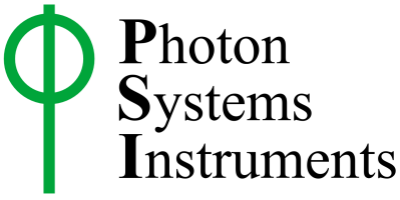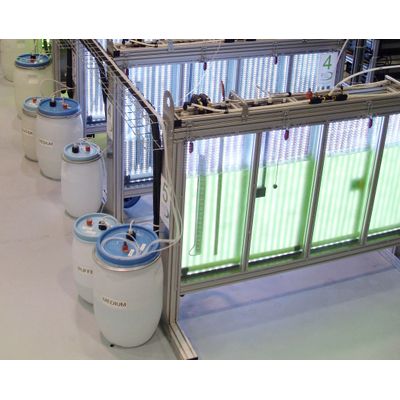

Photon Systems Instruments, spol. s r.o (PSI)
- Home
- Companies
- Photon Systems Instruments, spol. s r.o ...
- Products
- PSI - Large-Scale Photobioreactors

PSI - Large-Scale Photobioreactors
PSI Large-Scale Photobioreactors are systems that create a controlled artificial environment for upscaling of photosynthetic microorganisms’ production and their metabolites. Standard systems are based on flat cultivation vessel (25 l or 100 l in volume) whereas customized systems comprising range of various cultivation tanks that meets customers’ requirements. The cultivation unit is operated by the stand-alone Control Unit.
Most popular related searches
photobioreactor software
photobioreactor control
photobioreactor
tubular photobioreactor
photobioreactor system
cultivation control
cultivator
biomass production
- Flat cultivation vessel with a short light path for an optimal illumination
- Glass material suitable for steam- or chemical- sterilization
- Bi-color LED panel
- Precise control of cultivation conditions (illumination, temperature, aeration, etc.)
- Optical density and Chlorophyll-a ?uorescence determination
- Variable cultivation strategies (pH-stat, turbidostatic, anaerobic, etc.)
- Further upscaling by PBRs cascading
- Compact design with wheels for easier manipulation
- Customized versions
- Online software control
- Flat, rectangular glass cultivation vessel with a short light path (6.5 cm ± 5 %) for an optimal irradiance.
- Different size: 25 l, 100 l.
- Stainless steel vessel lid with gas and electronics fittings accompanied with silicone sealings.
- Integrated aeration plastic U-tube with porous polyethylene sparger (pore size 50 µm). Autoclavable (with limited reuse).
- Emptying valve.
- Hot steam or chemical sterilization.
- In-built temperature regulation in the range of 30 - 60 °C (with ambient temperature around 20 °C).
- Cooling module (optional) widens the temperature range to 15 - 60 °C (ambient temperature not exceeding 30 °C). It includes water cooling coil, cooling unit, electronics and software control.
- LED technology.
- Bi-color light panel with separately controllable channels.
- Cool white-red or cool white-blue. Other color combination on request.
- Total illumination intensity up to 500 and 200 µmol. m-2. s-1 for white and red light, respectively.
- Optionally, up to 2.000 µmol. m-2 . s-1 with the Light Upgrade (available only for 25 l PBR).
- Light path: 6.5 cm ± 5 %.
- Illumination is independently adjustable for light color in intensity, timing and modulation.
- Constant light conditions or the alternation of various light and dark cycles.
- The duration of the individual cycles: from seconds up to days.
- The mode of the light cycles: constant, linear increase or decrease, sinusoid mode for simple imitation of diurnal rhythms. Moreover, java scripting is incorporated in the Photobioreactor Control Software (advanced version) for a creation of the advanced light protocols (for example automatic light intensity adjustment in dependence on the actual biomass concentration).
- Additional Protective Glasses: Radiation safety glasses protecting against excessive LED radiation – equipped with side cover and protective filters. One pair of glasses is provided with the device free of charge.
- Aeration system provides mixing and also air/CO2 supply to cultures.
- Integrated aeration plastic U-tube with porous polyethylene sparger (pore size 50 µm). Autoclavable (with limited reuse).
- The air source: Air pump supplemented with a valve, which interrupts bubbling before the OD and fluorescence measurements to avoid any bubble interference with the measurements and thus to allow for more precise readings.
- Optionally, the Photobioreactor can be linked to the Gas Mixing System GMS 150 that provides precise concentration and flow rate of the required gases.
- Integrated Turbidimeter (OD 680 and 720 nm) and Double-Modulation Fluorometer (blue and red excitation lights) for automatic measurements (optional).
- The optical path of OD and Chl-a fluorescence measurement: 10 mm.
- OD 720 measures light scattering on particles and can serve as a proxy for biomass growth whereas OD 680 is linked to the chlorophyll absorption and can be used for an estimation of chlorophyll concentration.
- Chlorophyll-a fluorescence measurement can be used for a rough evaluation of the biomass physiological state. Blue and red excitation light. Determined parameters: F0, FT, FM, F’M, (F’M – FT/F’M).
- The Photobioreactor Control Software enables remote online visualization of recorded data in real-time. Moreover, the software allows to fit the OD data with the various regression functions to facilitate the evaluation of the actual growth rate.
- Electrode Module: enables connecting up to four measuring sensors to the Photobioreactor.
- Temperature sensor: Platinum Pt 1000 sensor.
- pH Module (optional) includes digital membrane pH sensor InPro 3253i/SG/325, cable, SW control.
- O2 Module (optional) to measure concentration of dissolved O2 (includes digital optical O2 sensor InPro 6860i/325, cable, SW control).
- CO2 Module (optional) to determine the dissolved carbon dioxide concentration in the medium (includes digital CO2 sensor InPro 5000i/325, cable, SW control).
- The highly flexible use is enabled through connection and control of several additional pumps. Such design allows to use any of the measured parameters (for example OD, pH, dCO2 or dO2, including information from water level sensors) as a control regulator in order to operate the system in automatic regime.
- Two PWM diaphragm pumps (optional) and up to 8 peristaltic pumps (optional) can be linked to the Photobioreactor for supply of different nutrients, medium, catalysts, inhibitors, toxicants, base or acid, organisms, etc.
- Batch cultivation
- Semi-continuous cultivation
- Turbidostatic cultivation
- Chemostatic cultivation
- Anaerobic cultivation
- Turbidostat Module (optional): maintains a pre-set cell concentration (determined through OD 680 or OD 720) in a constant biomass volume. The pre-set cell concentration can be constant, fluctuating in a various range or dynamically changed. The module includes two peristaltic pumps and supporting control software.
- Chemostat Module (optional): In chemostat mode pH value of the cultivation media is continuously adjusted by acid or base addition to the cultivation vessel in order to keep pH level on defined level. The module includes two peristaltic pumps (one pump serves adding acid, the other pump adds base).
- pH-Stat cultivation through Gas Mixing System GMS 150 (optional): The Photobioreactor Control Software.for GMS 150 enables to create a Java script that will keep the pH of the cultivation medium on defined level through a regulated gaseous CO2 addition.
- Anaerobic cultivation via gas-tight lid and N2 sparging.
- Vertical Tubular Airlift Photobioreactor is a modular system scalable between 100 – 1.000 l. Ambient or artificial LED illumination. Monitoring of OD 680, 720 and chlorophyll fluorescence. Additional probes: pH/T, dO2, CO2
- Stainless 1.000 l Photobioreactor. Temperature controlled cultivation tank with the immersed LED lighting and integrated sparging system. Monitoring of OD 680, 720 and chlorophyll fluorescence. Additional probes: pH/T, dO2, CO2
- Modular Helical Tubular Photobioreactor (250 l per one unit) with a degassing system. Ambient or artificial LED illumination. Monitoring of OD 680, 720 and chlorophyll fluorescence. Additional probes: pH/T, dO2, CO2
- The entire Photobioreactor system and all its cultivation and monitoring functions and accessories can be controlled via the Photobioreactor Control Software. The control software provides intuitive and dynamic interface for online monitoring and visualization of all measured data as well as creation of user-defined protocols.
- An advance version of Photobioreactor Control Software must be ordered for large-scale Photobioreactor.
- For more details see our website about the Photobioreactor Control Software.
- Verification of cultivation upscaling
- Biomass production
- End-product yield optimization
